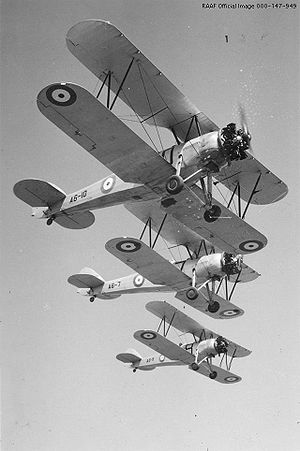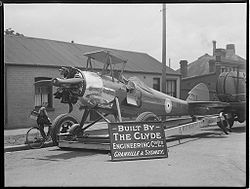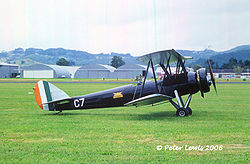Avro 643 Cadet Video - Picture

|
|
Avro 643 Cadet
Cadet

Picture - RAAF Avro Cadets
Role: Trainer
Manufacturer: Avro
First flight: October 1931
Introduced: 1932
Produced: 1932 - 1939
Number built: 104
Developed from: Avro Tutor
Variants: Avro 638 Club Cadet
The Avro Cadet was a single-engined British biplane trainer designed and built by Avro in the 1930s as a smaller development of the Avro Tutor for civil use.
Design and development
The Avro 631 Cadet was developed in 1931 as a smaller, more economical, derivative of the Tutor military trainer, for flying club or personal use. The first prototype, G-ABRS flew in October 1931. It was publicly unveiled at the opening of Skegness airfield in May 1932, although by this time, the first orders for the type, for the Irish Army Air Corps, had already been placed and the order (for six Cadets) delivered.
The Avro 631 Cadet was replaced in production in September 1934 by the improved Avro 643 Cadet, which had a revised rear fuselage with a raised rear seat, retaining the 135 hp (101 kW) Armstrong Siddeley Genet Major 1 engine of the Avro 631. In turn, this formed the basis for the more powerful Avro 643 Mk II Cadet; it was also strengthened and had improved parachute egress. This model entered service in 1935, and was built in the largest numbers, including 34 fitted with a tail wheel for the Royal Australian Air Force.
Operational history
The Cadet, while smaller and more economical than the Tutor, was still more expensive to run than competing two-seat light civil aircraft and was harder to hangar because of its lack of folding wings; so was mainly used as a trainer for flying schools or the military. By far, the largest civil user was Air Service Training Ltd, which operated 17 Avro 631s at Hamble, together with a further four operated by its Hong Kong subsidiary, the Far East Aviation Co. Air Service Training also operated 23 Mk II Cadets, with both these and the earlier Cadets remaining in service with Reserve Training Schools run by Air Service Training until they were impressed as ATC instructional airframes in 1941.
The other major operator was the RAAF, which acquired 34 Mk II Cadets, delivered between November 1935 and February 1939. These remained in service until 1946, when the surviving 16 were sold for civil use. Two of these were re-engined in 1963 with 220 hp (160 kW) Jacobs R-755 engines for use as crop sprayers. In the U.K., only two Cadets survived the war.
Variants
Avro 631 Cadet Initial version, powered by Armstrong Siddeley Genet Major I engine, 35 built. Avro 643 Cadet Raised rear seat, 8 built. Avro 643 Mk II Cadet Powered by 150 hp (110 kW) Genet Major 1A, 61 built.
Operators

Picture - A RAAF Avro Mk II Cadet built Manchester U.K. (despite the signboard) and erected in Australia
Civil operators
United Kingdom
Air Service Training Ltd
Military operators
Australia
Royal Australian Air Force operated 34 Avro 643 MkII Cadet.
Ireland
Irish Air Corps operated 7 Avro 631 Cadets.
Portugal
Portuguese Air Force
China
China had 5 Avro 631 deployed at Liuzhou Aviation School during the Second Sino-Japanese War, all of which were lost due to Japanese bombing in 1939.
Spain
Spanish Republican Air Force
Survivors

Picture - Ex-Irish Air Corps C.7 flying in New Zealand as ZK-AVR
As of 2008, there are two Cadets flying in Australia (VH-AEJ and 'AGH), one in Ireland (the last of the Irish Air Corps machines, though home after a long tour of duty via the U.K. and New Zealand as ZK-AVR) and one reputed airworthy in the Museu do Ar, Portugal.
Specifications (Avro 643 Mk II Cadet)
Data from Avro Aircraft since 1908
General characteristics
Crew: Two
Length: 24 ft 9 in (7.55 m)
Wingspan: 30 ft 2 in (9.20 m)
Height: 8 ft 10 in (2.69 m)
Wing area: 262 ft² (24.3 m²)
Empty weight: 1,286 lb (585 kg)
Loaded weight: 2,000 lb (907 kg)
Powerplant: 1x— Armstrong Siddeley Genet Major 1A seven cylinder radial, 150 hp (112 kW)
Performance
Maximum speed: 116 mph (101 kn, 187 km/h)
Cruise speed: 100 mph (87 kn, 161 km/h)
Range: 325 mi (283 nmi, 523 km)
Service ceiling: 12,000 ft (3,660 m)
Rate of climb: 700 ft/min (3.6 m/s)
Wing loading: 7.63 lb/ft² (37.4 kg/m²)
Power/mass: 0.075 hp/lb (0.12 kW/kg)
Related development
Avro Tutor: Cadet developed from this
Avro 638 Club Cadet: developed Cadet with folding wings
Avro 643 Cadet Pictures and Avro 643 Cadet for Sale.
Living Warbirds: The best warbirds DVD series.
Source: WikiPedia